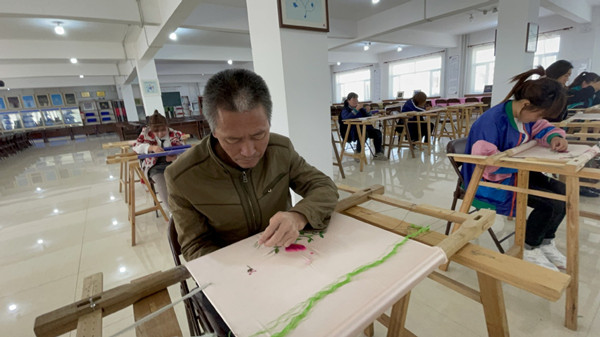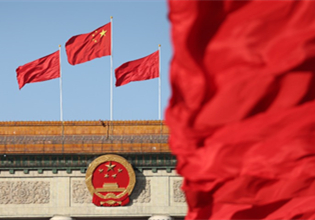Ex-mason stitches together a new career

Cao Feng works on a piece of Mongolian embroidery in Horqin Right Wing Middle Banner, Hinggan League, Inner Mongolia autonomous region, this month. [Photo by Yang Zekun/China Daily]
After a year of concentrated practice, former mason Cao Feng became a skilled Mongolian embroidery craftsman in 2018.
The 48-year-old man from Horqin Right Wing Middle Banner in Hinggan League, Inner Mongolia autonomous region, previously knew little about Mongolian embroidery, a type of national intangible cultural heritage, but he turned to the craft after serious damage to his hips robbed him of the ability to do heavy manual work.
Four years ago, Cao learned he could receive free training in embroidery and work from home, so he decided to give it a go. As the breadwinner in the family, he was eager to find a way to earn more money to support his son through college.
"I thought embroidery was more suitable for women, and I was worried whether I could learn it with my mason's hands, because the two jobs are so different," he said.
"In the beginning, my hands were stiff and I knew nothing about using a needle, but these beautiful flowers let me see the hope."
To improve his skills more quickly, Cao often practiced from early morning to midnight. That helped him earn more from his embroidery and he now makes about 60,000 yuan ($9,300) a year.
Mongolian embroidery-which originated during the Qing Dynasty (1644-1911)-combines Mongolian ethnic and regional characteristics, said Bai Jingying, head of the banner's legislature.
"Mongolian embroidery contains a large number of elements such as flowers and plants, landscapes and scenes of life on the grassland, and it uses bright colors to express our blessing," she said, adding that the embroidery works are often stitched onto clothing, pillows or quilts for sale.
In 2016, Bai started to promote the skill and help poor local residents find a way to earn more money during the slack season for farming and climb out of poverty. More than 26,000 people have since received training and are producing embroidery to make a living.
Medical tradition
To effectively preserve, pass on and develop the traditional culture of ethnic groups, the central government has taken multiple measures to integrate cultural elements into people's daily lives and benefit them economically and spiritually.
In 2016, the State Council Information Office issued the third National Human Rights Action Plan (2016-20), guaranteeing the cultural rights of ethnic groups, the protection and inheritance of their traditional cultures and increased support for distinctive ethnic culture industries.
Mongolian medicine is another aspect of traditional Mongolian culture. For centuries, people on the grassland counted on Mongolian medicine, which absorbed a lot of experience and treatment methods from traditional Chinese and Tibetan medicine in its development, said Xiao Qiang, director of the Tongliao Mongolian Medicine Industry Development Office.
He said protecting and developing Mongolian medicine plays an immeasurable role in the inheritance of ethnic culture.
Tongliao, a city in the eastern part of Inner Mongolia that is known as the capital of Mongolian medicine, has formed a system for cultivating Mongolian medicine talent and researching, developing and producing Mongolian medicine.
To ensure residents have access to Mongolian medicine services, all general hospitals and more than 90 percent of township and community health centers in Tongliao have set up Mongolian medicine departments, Xiao said.
Inner Mongolia has also included Mongolian medicine in its medical insurance scheme, meaning residents can have most of their expenses reimbursed.
"Mongolian medicine has a broad mass base, and we found that more residents at the grassroots level tend to choose Mongolian medicine," Xiao said.
Tongliao has collected 388 Mongolian medical literature tracts dating back to the 11th century. It has 1,350 Mongolian medical professionals, and the output value of its Mongolian medicine industry chain reached 3.84 billion yuan last year, according to the office.
Protecting the culture of ethnic groups has always been an important part of China's development, ensuring they have equal rights to development without discrimination in language, customs and way of life, said Li Yunlong, a professor with the Party School of the Central Committee of the Communist Party of China.
The protection and inheritance of their traditional ethnic culture is a basic right of ethnic groups, and also the basis of their identity, Li said.



 Print
Print Mail
Mail





